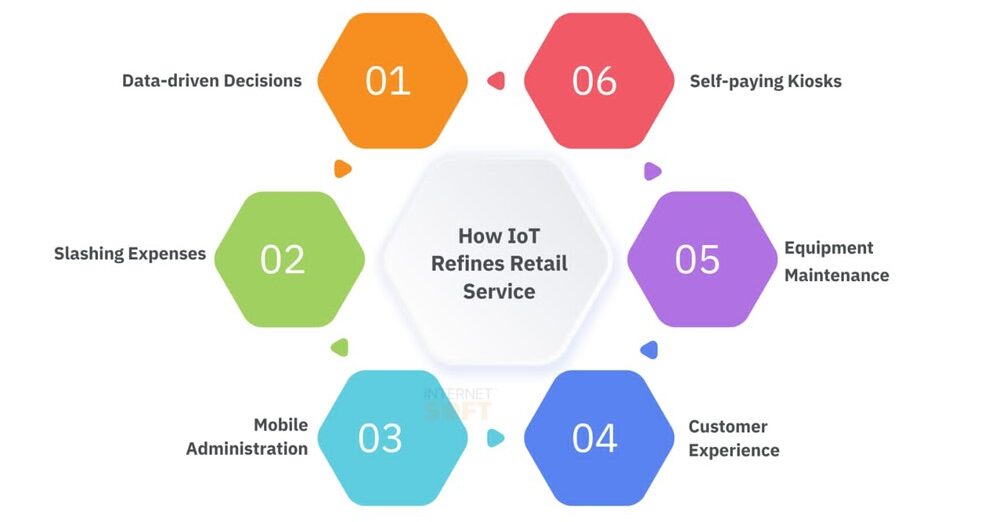The Future of Retail: How IoT is Revolutionizing E-commerce
- 1 What is the Internet of Things?
- 2 Advantages of IoT in Retail
- 3 Conclusion
- 3.1 FAQs:
- 3.1.1 What is IoT in retail?
- 3.1.2 How does IoT benefit retailers?
- 3.1.3 What role do mobile applications play in retail?
- 3.1.4 How can retailers improve customer retention?
- 3.1.5 What is an omnichannel strategy in retail?
- 3.1.6 How can IoT help retailers manage supply chain issues?
- 3.1.7 How can Internet Soft assist retailers in digital transformation?
In Short:
- IoT Integration: The retail industry is evolving with digital technologies, enhancing inventory management and customer experience.
- Advantages of IoT: From data-driven decisions and expense reduction to improved customer experience through mobile applications and self-paying kiosks, IoT offers numerous benefits to retailers.
- Ecosystem Collaboration: Success lies in retailers fostering partnerships across the supply chain, leveraging technologies like Bluetooth beacons and RFID tags to create a thriving ecosystem.
The retail industry is set for a massive change. The sector will integrate digital technologies to appeal to its audience. The industry began with mom-and-pop stores and existed in the current form of retail chains. Customers have shifted from physical shopping to online shopping. Retailers have changed how they track goods from warehouses to ensure their inventory is updated.
Retail stores have become retail chains by utilizing technology and human resources. The onus of convenience placed on retailers has ensured stores adhere to deadlines to gain good returns. A customer lost is a customer never returning.
The landscape has changed from aisle shopping to self-pickup kiosks and evolved from paying in cash to scanning your cards for cashless transactions. As technology upgrades once more, the retail industry must embrace the newest gift from the Internet – the Internet of Things (IoT). IoT application development emerges as a crucial facet, as IoT solutions can identify inefficiencies within the retail value chain, providing valuable insights to inform decisions and maximize productivity.
What is the Internet of Things?
The Internet of Things is a group of connected devices, sensors, and tags that retail stores can utilize to control the supply of goods. It can distinguish between humans, objects, and other devices and transfer information without human intervention.
Retailers should understand the power of automation. It cuts down costs, lowers the dependency on human resources, and runs operations efficiently. IoT-powered retail automation can optimize operations, gain analytics from devices, and help retailers make essential business decisions. IoT solutions showcase a viable solution to prevent stock shortages in inventory and provide an omnichannel solution.
Advantages of IoT in Retail
The retail industry is suffering from abandoned carts. They have lost customers due to various mobile applications providing the same service. IoT solutions can boost the customer experience and change how they attract customers.
- Data-driven Decisions – The data accumulated by IoT devices in a retail setup picks up customer shopping patterns. This provides insights to retailers to design their stores anew to ensure guaranteed returns.
- Slashing Expenses – IoT solutions help retailers manage warehouse costs and operational expenses. Retailers can curb warehouse costs by using IoT sensors to control temperatures on perishable products, replenish the most wanted inventory, and manage orders. Furthermore, RFID tags can help locate warehouse items quickly and attain items for fulfilling large clients’ orders.
- Mobile Administration – Retailers can manage the warehouse inventory or operations through a single tablet or mobile device. Mobile applications can track the efficiency of the administration and workers. Furthermore, it assists in the distribution of assets, lowering the burden on workers and reducing errors.
- Self-Paying Kiosks – Since customers love convenience and hate waiting in long lines, self-paying kiosks ensure fewer waiting lines and more shopping. The latest payment transaction networks and digital payment applications will support the kiosks. Smart vending via IoT solutions will reduce the dependence on human staff and encourage digital spending.
- Equipment Maintenance – Large refrigerators hold perishable items but can malfunction due to unforeseen circumstances. Store managers in retail outlets need to leverage IoT solutions to get real-time updates on malfunctioning equipment.
- Customer Experience – Customers will be elated by the ease of shopping. Mobile applications can assist customers in buying items in advance and storing them in their shopping carts. The IoT sensors can even guide customers in getting items in faraway aisles within the same retail chain. Targeted Ads at customers can ensure that items get sold, and tailored discounts can bring in additional footfall.
Collaboration is the Key to Success
The Internet of Things may keep operations in check, but customer retention is another matter. Customers are fickle and may go to the retailer next door. A retailer ecosystem will ensure customers continuously trickle in and check out successfully. A flourishing ecosystem comprises manufacturers, suppliers, distributors, retailers, fulfillment hubs, and customers. It can create lifetime value and drive down customer acquisition costs.
Integrating the latest technologies like Bluetooth beacons and RFID tags can ensure the ecosystem can thrive. Retailers need to provide insights to suppliers and distributors to assure guaranteed returns. Opportunities in retail do exist in third-party marketplaces by entering new categories or merchandising. However, e-commerce is a surefire way for retailers to enter the online pool.
Retailers must invest in e-commerce application development to expand their reach and customer base.
Mobile Applications
Mobile applications hold the key for retailers to gain customers. It can provide insights into customer search patterns, frequency of buying repeated items, and ease provided to customers. Retail and e-commerce application development go together to create a mobile application that alleviates the pain points of customers’ online shopping.
Customers can be engaged through nudges or notifications about sudden sales or discounts on certain items. It can make it convenient for customers to order home delivery items, and IoT helps replenish out-of-stock items from the nearest dark stores. Furthermore, retailers can use customer data from e-commerce mobile applications to optimize offers and maximize sales.
Retailers can utilize physical stores and warehouses to stock essential items and online stores to track orders. They can align all channels for a unified shopping experience, also known as an omnichannel strategy. This will help retailers keep track of customer demand and innovate as the demand changes. All processes need to work together to attain consistent success.
Conclusion
If a retailer suffers from supply chain issues, they should seek the assistance of IoT solutions to eliminate inefficiencies in their operations. The technology can pinpoint problems in their supply chain and provide feasible solutions.
Internet Soft is a software development company in California with a team of intelligent thinkers and talented professionals. Internet Soft provides customized IoT solutions to help retail chains in their digital transformation journey and digitize upstream processes. Manage your retail store through digital point-of-sale machines to culminate in short lines and inventory management software to track goods in the warehouse.
Want to race ahead of your retail competition? Consult Internet Soft today for a quick resolution.
FAQs:
What is IoT in retail?
IoT (Internet of Things) in retail refers to the use of connected devices, sensors, and tags to optimize operations, improve inventory management, and enhance customer experiences in retail stores.
How does IoT benefit retailers?
IoT enables retailers to make data-driven decisions, reduce expenses through automation, enhance customer experiences with self-paying kiosks and mobile applications, and improve inventory management and equipment maintenance.
What role do mobile applications play in retail?
Mobile applications play a crucial role in retail by providing insights into customer behavior, offering convenience for online shopping, engaging customers with notifications and discounts, and facilitating a unified shopping experience across channels.
How can retailers improve customer retention?
Retailers can improve customer retention by investing in technologies like IoT to enhance customer experiences, fostering collaboration across the retail ecosystem, and providing personalized offers and services through mobile applications.
What is an omnichannel strategy in retail?
An omnichannel strategy in retail involves aligning all sales channels, including physical stores, online stores, and mobile applications, to provide customers with a seamless shopping experience and optimize inventory management.
How can IoT help retailers manage supply chain issues?
IoT can help retailers manage supply chain issues by identifying inefficiencies in operations, tracking inventory in real-time, and providing insights to optimize logistics and inventory management processes.
How can Internet Soft assist retailers in digital transformation?
Internet Soft offers customized IoT solutions, digital point-of-sale machines, and inventory management software to help retailers streamline operations, enhance customer experiences, and stay ahead of competition in the digital age.


















